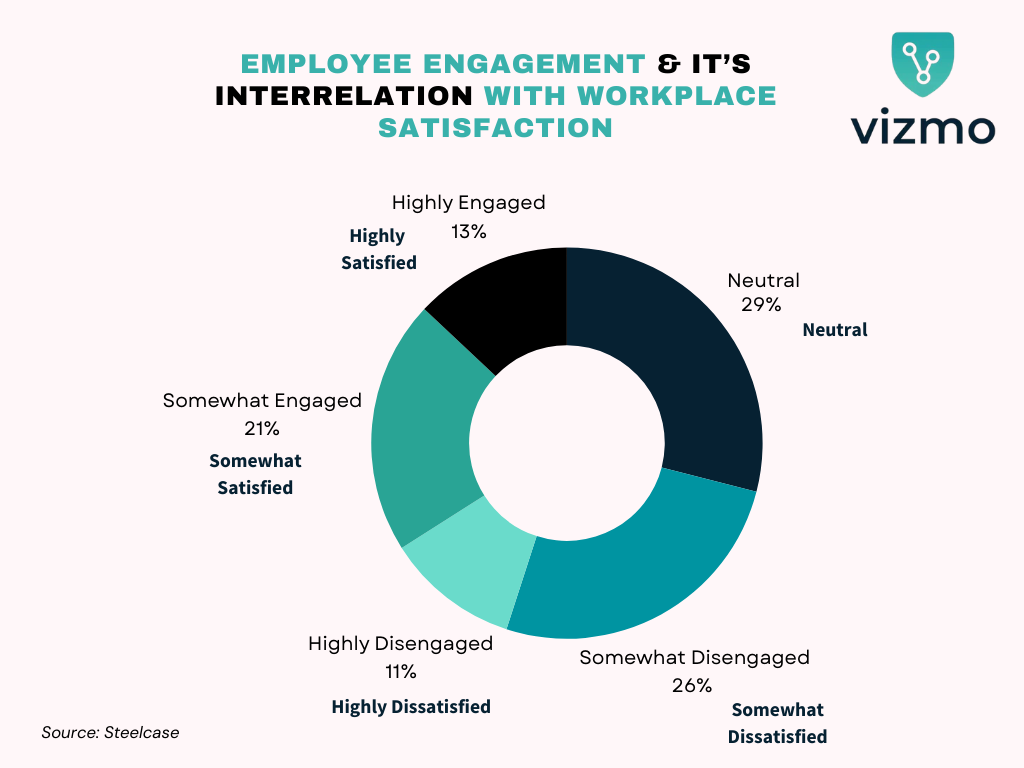Ideas to Improve Workplace in 2024

Workplace improvement is crucial in today's rapidly evolving business landscape, especially as the nature of work changes and the behaviour and ethics of the modern workforce evolve, posing a challenge for organizations to improve workplace experiences in new and innovative ways. And when we talk about workplace improvement, it is essential to talk about turning the workplace into a productive ecosystem that ensures employee productivity and contributes to the overall, integral improvement of the organisation. Therefore, organizations have to think about innovative ideas to improve the workplace experience.
Employee productivity is directly linked to overall workplace productivity. If an individual employee is productive, it contributes to the productivity of the entire organization and vice-versa. Employee productivity and workplace productivity should not be viewed in isolation; they are interconnected. If we delve a little deeper into this idea, we find that productivity is more about the system than individual units of the system. Hence, Improving the system (workplace and workflows) will increase individual productivity.
94% of most problems and possibilities for improvement belong to the system, not the individual. I would argue that most productivity improvements belong there as well. Personal solutions can be useful, but the most effective antidote to low productivity and inefficiency must be implemented at the system level, not the individual level.
Enhancing the workplace environment has a direct correlation with business performance and an indirect impact on the organization's revenue metrics. The superstructure serves as the foundation for many substructures, such as revenue, employee satisfaction, work ethics, and employee engagement. On the other hand, employees have a better work-life balance, improved employee health, are more efficient in meeting deliverables, and, most importantly, they feel valued at work.
The top six most productive countries are in Scandinavia, and they are definitely at the top of the Happiness Index as well. Happiness is directly proportional to productivity. They are at the top because they understand the value of a positive work environment. A workplace is nothing without an effective workforce. Simply put, employees want "feel good productivity," not just "look good productivity." They want to be proud of their work, which will lead to personal and professional advancement. As a result, improving the workplace is of the utmost importance for promoting effective growth.
According to data given by Steelcase, only 13% of global workers are highly engaged and satisfied with their jobs.

Therefore, it's important to create a productive workspace that keeps employees engaged, boosts their morale, and makes their work life productive. This will provide them with work satisfaction and help to keep the employee turnover rate low.
In this article, we will discuss an array of innovative ideas to improve workplace productivity. We will thoroughly explore the scope of these workplace improvement ideas and how they can cultivate an encouraging and positive work environment. Furthermore, we will discuss how these enhancements can effectively empower employees, motivating them to leverage their skills and talents to their fullest potential, thereby contributing significantly to the overall success of their organization.
How Do You Improve a Workplace?
To achieve an ideal workplace ecosystem, one must first have a clear and distinct plan in mind. Strategizing and executing those plans are necessary steps to improve a workspace. However, the effort should not stop once the workplace is optimized. Workplace improvement is an ongoing process where continuous tweaks and adjustments are made. This aims to continually enhance the workplace environment through innovation and cutting-edge solutions.
So, when it comes to improving the workplace experience, there are three major areas to consider: mode of work, workplace infrastructure, and employee well-being. Now, let's take a look at some workplace improvement ideas:
1. Hybrid Work Culture for a Perfect Work-Life Balance
The hybrid mode of work, blending remote and onsite elements, presents a compelling alternative supported by data and insights. Research indicates that hybrid work models can enhance productivity and job satisfaction significantly. According to a study by Harvard Business Review, organizations embracing hybrid work report a 25% increase in employee productivity compared to traditional office setups. This increase is attributed to the flexibility offered by hybrid work, accommodating diverse working preferences and styles.
Moreover, a survey conducted by Gallup found that employees in hybrid work arrangements exhibit higher levels of job satisfaction, with 65% reporting feeling engaged compared to 58% in fully remote roles and 61% in solely onsite positions. This boost in job satisfaction is directly linked to the flexibility inherent in hybrid work, allowing employees to balance their professional and personal lives effectively.
In addressing the challenges of workplace isolation in remote setups and the work-life balance issues prevalent in onsite roles, the hybrid model emerges as a strategic solution. Particularly in the post-pandemic landscape, where the need for flexibility and adaptability is paramount, the prominence of hybrid work setups continues to grow as a vital antidote to these pressing workplace concerns.
Workplace Analytics: A valuable tool for organizations using a hybrid work model.
Workplace analytics is the process of capturing, analyzing, and making decisions based on data gathered about the workforce density in a given office space. It has become crucial in determining the optimal way to utilize space in a hybrid work model, where employees have the flexibility to work from home or the office. By analyzing workplace analytics, organizations can redefine the flexible workplace for better productivity, manage the available office space, optimize real estate costs, promote employees' productivity and efficiency, make workplaces more secure, prepare ahead for guests, and enhance the overall workplace experience.
2. Improve Operational Efficiency with an Effective Work Management Software.
A productive workplace is often characterized by its system, such as an efficient Work Management Software. A productive workplace is frequently defined by its system, such as effective work management software. This system facilitates seamless interactions and real-time collaborations and employs cutting-edge technology to streamline the overall workflow. It automates the workflow and seamlessly synchronizes various apps via API integration, eliminating the need for manually doing repetitive tasks. This saves the organization time and resources, resulting in increased operational efficiency.
Desk booking solutions and meeting rooms are vital tools in a hybrid workspace. With unique workplace and desk mapping solutions, desk booking simplifies employees' lives by offering them the freedom to select their preferred workspace. It efficiently manages workspace density and aids in organizing, managing, and optimizing desk usage. Meeting rooms, on the other hand, are responsible for effectively assigning various amenities such as seats, TV, projector, whiteboard, and so on, allowing employees to make informed decisions. Aids in the customisation of room availability. These two tools also help to improve collaboration and communication among co-workers, resulting in a positive and supportive work environment.
3. Promoting Employee Mental Health and Well-being: Strategies for a Healthier and Happier Workforce
The mental health and overall well-being of employees profoundly affect their productivity and workflow. Creating a stress-free work environment increases employee productivity while keeping them engaged and happy at work. According to the World Health Organisation, depression and anxiety cause an estimated 12 billion working days lost worldwide each year, costing US$1 trillion in lost productivity.
To enhance the workplace environment for mental health and well-being, it's vital to address both the physical and digital infrastructure of the organization. Here are some suggested improvements to create a shift in your employees' moods and overall well-being ⬇️
1. Incorporate natural light: Numerous studies have shown that having ample amount of natural light in the workplace improves employee focus and productivity. Academic research has found that workers with natural daylight in their office environments reported a 51% drop in the incidence of eyestrain, a 63% drop in the incidence of headaches, and a 56% decrease in drowsiness. Natural light also regulates the body's circadian rhythms (natural body clock), which aids in getting rid of insomnia and sleep deprivation at the workplace.
2. Add plants to the work desk: Greenery and sunlight both improve the overall well-being of employees at work. According to the Human Spaces report on The Global Impact of Biophilic Design in the Workplace, employees who work in natural environments experience 15% higher levels of well-being, 6% higher productivity, and 15% higher creativity.
3. Minimalism at work: The minimalist approach to work streamlines the workflow, increasing efficiency, clarity, and focus. It can declutter the workspace, making employees' lives easier and more efficient by prioritizing tasks.
4. Digital Detox: Implementing a digital detox strategy, which includes providing employees with breaks from screen time and opportunities for power naps, can significantly enhance workplace productivity. Research indicates that prolonged periods of working without breaks can result in chronic health issues over time. Therefore, it's crucial to avoid sleep deprivation and limit screen time to no more than 8 hours per day, as excessive screen exposure can impair brain processing, eye strain, obesity etc. Introducing digital detox initiatives and regulating screen time can prove beneficial for employees and the workplace.
Moreover, offices can designate specialized areas for fitness, mindfulness activities, yoga, meditation, and napping pods to further support employee well-being.
5. Company events and Social activities: One of the most important aspects of a company is the development of interpersonal relationships and connections among employees within the organisation. Strong social bonds enhance the workplace environment by encouraging collaboration, teamwork, and overall job satisfaction. There are myriads of ways which can improve the social bonding between employees.
i. Host company events - Host company events to encourage team building and collaboration among employees; this will improve socialisation and provide them with a sense of belonging.
ii. Celebrate small wins - Acknowledge and celebrate small wins within your team, fostering a culture of appreciation and motivation. Hold regular recognition ceremonies or create a digital platform where team members can publicly applaud each other's accomplishments, thereby reinforcing a positive and supportive work environment.
iii. Lounge activities: Incorporate games and fun activities in your lounge area to promote relaxation and team bonding. Studies show that employees who engage in leisure activities during breaks report higher levels of job satisfaction and reduced stress levels.
Why Workplace Improvement Matters?
Investing in workplace improvements can yield substantial long-term cost savings by diminishing absenteeism and enhancing overall employee well-being. Moreover, such investments significantly influence employee satisfaction, bolster productivity, and ultimately drive the overall success of the business. By creating an environment that prioritizes employee comfort, safety, and engagement, organizations foster a culture of innovation and creativity, thereby ensuring sustainable growth for both the employees and the organization. Furthermore, improved workplace conditions contribute to higher retention rates, reducing recruitment and training expenses while nurturing a loyal and motivated workforce. Additionally, a positive work environment enhances the organization's reputation by attracting top talent and fostering strong relationships with clients and stakeholders.
Advantages of an Improved Workplace Environment
- Increased Productivity: Studies show that employees in well-designed workplaces are up to 20% more productive. (Source: Gensler's Workplace Survey 2022)
- Higher Employee Satisfaction: A comfortable and positive work environment leads to a 12% increase in employee satisfaction. (Source: Gallup)
- Enhanced Employee Well-being: Improved workplace conditions reduce stress levels by 25%, leading to better mental and physical health. (Source: World Green Building Council)
- Better Talent Retention: Organizations with attractive workplaces experience a 10% increase in employee retention rates. (Source: Society for Human Resource Management)
- Boosted Innovation and Creativity: Employees in well-designed environments are 20% more likely to engage in innovative activities. (Source: Leesman Index)
- Positive Company Culture: A welcoming and inclusive workplace fosters a strong company culture, resulting in 30% higher employee engagement. (Source: Great Place to Work Institute)
- Improved Customer Satisfaction: Employees in conducive work environments deliver better customer service, leading to a 20% increase in customer satisfaction. (Source: Capgemini)
Improving the workplace is critical for driving business growth, as employee productivity and organizational success go hand in hand. By focusing on strategies such as hybrid work setups, streamlined work management tools, and employee well-being initiatives, we can create a positive environment that fuels productivity and promotes growth. Understanding the relationship between employee and workplace productivity emphasizes the importance of long-term changes rather than quick fix solutions. In accordance with recent office management trends influencing our approach to work, there are numerous innovative ideas ready to transform our workspace into one that nurtures talent, fosters collaboration, and propels us to success in today's competitive landscape.
Consider implementing these strategies today to foster a positive work environment and drive organizational success.
FAQ’s
Why Is a Positive Work Environment Important?
A positive work environment is an ecosystem where employees are respected, nurtured, rewarded, and engaged. It boosts employee morale and productivity. It promotes collaboration, creativity, and job satisfaction, which results in better outcomes for both employees and the organization.
What Mistakes Can Impact Your Workplace Environment?
Mistakes such as poor communication, lack of recognition, micromanagement, and ignoring employee feedback can all have a negative impact on the workplace. These issues can cause employee disengagement, low morale, and decreased productivity.
What Are Signs of a Toxic Workplace?
A toxic workplace is characterized by high employee turnover, frequent conflicts, a lack of transparency, favoritism, and high levels of stress. Excessive micromanagement, the presence of a dominance hierarchy, and less autonomy in work. Employees may also feel burnt out, anxious, or dissatisfied with their work environment.

